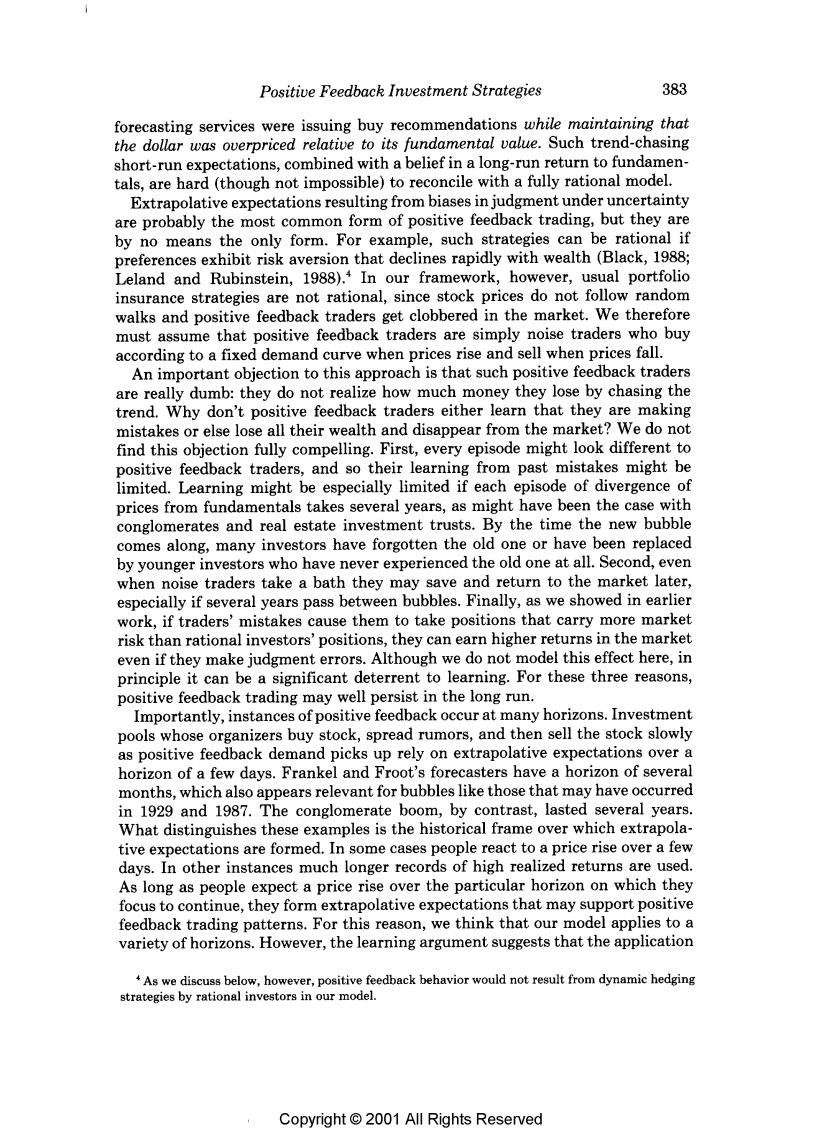正在加载图片...

Positive Feedback Investment Strategies 383 forecasting services were issuing buy recommendations while maintaining that the dollar was overpriced relative to its fundamental value.Such trend-chasing short-run expectations,combined with a belief in a long-run return to fundamen- tals,are hard (though not impossible)to reconcile with a fully rational model. Extrapolative expectations resulting from biases in judgment under uncertainty are probably the most common form of positive feedback trading,but they are by no means the only form.For example,such strategies can be rational if preferences exhibit risk aversion that declines rapidly with wealth(Black,1988; Leland and Rubinstein,1988).In our framework,however,usual portfolio insurance strategies are not rational,since stock prices do not follow random walks and positive feedback traders get clobbered in the market.We therefore must assume that positive feedback traders are simply noise traders who buy according to a fixed demand curve when prices rise and sell when prices fall. An important objection to this approach is that such positive feedback traders are really dumb:they do not realize how much money they lose by chasing the trend.Why don't positive feedback traders either learn that they are making mistakes or else lose all their wealth and disappear from the market?We do not find this objection fully compelling.First,every episode might look different to positive feedback traders,and so their learning from past mistakes might be limited.Learning might be especially limited if each episode of divergence of prices from fundamentals takes several years,as might have been the case with conglomerates and real estate investment trusts.By the time the new bubble comes along,many investors have forgotten the old one or have been replaced by younger investors who have never experienced the old one at all.Second,even when noise traders take a bath they may save and return to the market later, especially if several years pass between bubbles.Finally,as we showed in earlier work,if traders'mistakes cause them to take positions that carry more market risk than rational investors'positions,they can earn higher returns in the market even if they make judgment errors.Although we do not model this effect here,in principle it can be a significant deterrent to learning.For these three reasons, positive feedback trading may well persist in the long run. Importantly,instances of positive feedback occur at many horizons.Investment pools whose organizers buy stock,spread rumors,and then sell the stock slowly as positive feedback demand picks up rely on extrapolative expectations over a horizon of a few days.Frankel and Froot's forecasters have a horizon of several months,which also appears relevant for bubbles like those that may have occurred in 1929 and 1987.The conglomerate boom,by contrast,lasted several years What distinguishes these examples is the historical frame over which extrapola- tive expectations are formed.In some cases people react to a price rise over a few days.In other instances much longer records of high realized returns are used. As long as people expect a price rise over the particular horizon on which they focus to continue,they form extrapolative expectations that may support positive feedback trading patterns.For this reason,we think that our model applies to a variety of horizons.However,the learning argument suggests that the application +As we discuss below,however,positive feedback behavior would not result from dynamic hedging strategies by rational investors in our model. Copyright 2001 All Riahts Reserved